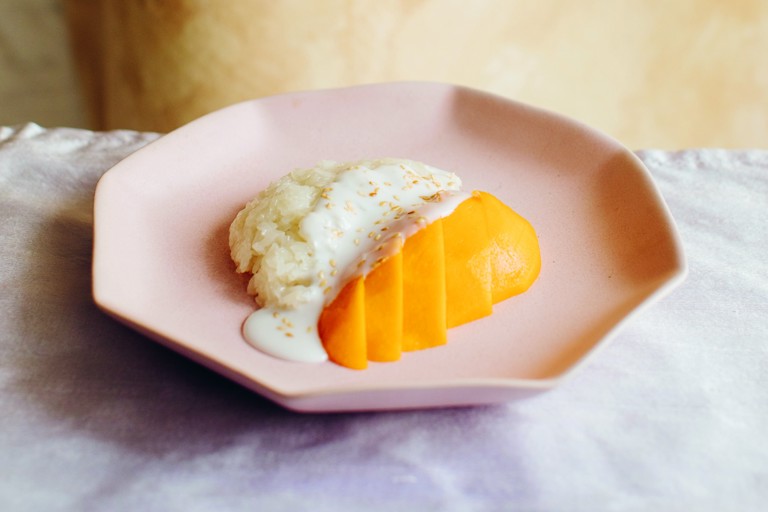Mamuang khao neow
John says: "This has to be the quintessential Thai dessert beloved around the world. There aren’t many components to the dish, so each ingredient should be sourced well. Thailand is blessed with incredible mangoes and the yellow ones are hard to match in flavour. I personally wait until the Indian Alphonso and Kesar mango season (May–August), as they not only have a similar look to the yellow-skinned mangoes of Thailand, but, more importantly, they have the same amazing flavour. If you want to go the extra mile, then make your own coconut cream (pages 208–209 in Kin Thai) as this recipe showcases how fantastic freshly squeezed coconut cream can taste – creamy, rich and pure!"
Ingredients
Metric
Imperial
Mango Sticky Rice
- 150g of sticky rice
- 200ml of coconut cream, (the richer, heavier solids that rise to the top of the thinner milk)
- 1 pandan leaf, knotted (optional, but very desirable)
- 120g of caster sugar
- 1 tsp salt
- 300g of mango, (it should be well ripened)
- 1 tsp white sesame seeds
Gati waan (sweetened coconut cream)
- 150ml of coconut cream, (the richer, heavier solids that rise to the top of the thinner milk)
- 1 pandan leaf, (optional, but very desirable)
- 1 1/2 tbsp of caster sugar
- 1/4 tsp salt
- 1/2 tsp rice flour
Method
Soak the sticky rice in enough water to cover it by 5cm. Leave the rice to soak for at least 5 hours, or overnight (even better)
- 150g of sticky rice
To make the sweetened thick coconut cream, put the coconut milk, pandan leaf (if using), sugar and salt into a large saucepan. Warm over a low heat for 5 minutes, stirring constantly, until the sugar has dissolved. Mix the rice flour and a little of the warm coconut cream together in a small bowl until a smooth paste forms, then stir this mixture back into the pan of sweet coconut cream. Warm for another minute, stirring constantly, until the sweet coconut cream becomes thick enough to coat the back of a spoon. Leave to cool to room temperature
- 200ml of coconut cream, (the richer, heavier solids that rise to the top of the thinner milk)
- 1 pandan leaf, knotted (optional, but very desirable)
- 120g of caster sugar
- 1 tsp salt
- 1/2 tsp rice flour
Strain the soaked rice, then transfer to a large bowl. Rinse under cold running water, stirring the rice with the water. Pour off the cloudy water and repeat this process twice more
Pour water into a steamer pot to a depth of 5cm and bring to the boil over a high heat, then reduce to a simmer. Transfer the rice to a perforated steamer and shape into a rough mound. Place the steamer over the boiling water and steam for 25 minutes until the grains are fully tender but slightly chewy
Meanwhile, put the coconut milk, pandan leaf, if using, sugar and salt into another saucepan and warm over a low heat for 5 minutes, stirring constantly, until the sugar has dissolved. The coconut cream will taste excessively sweet, but it needs to be in order to properly season the cooked sticky rice
- 200ml of coconut cream, (the richer, heavier solids that rise to the top of the thinner milk)
- 1 pandan leaf, knotted (optional, but very desirable)
- 120g of caster sugar
- 1 tsp salt
Once the sticky rice is cooked, transfer to a plastic container and pour over the second batch of prepared coconut cream. Mix well to completely incorporate the coconut cream mixture with the rice grains. It’s important the rice is hot as this will allow the grains to fully absorb the liquid and become attractively glistening. Cover the surface of the sticky rice with clingfilm (plastic wrap), then cover the container with a lid. Leave to stand in a warm place for 10 minutes to allow the cream to be fully absorbed and the rice to rest. Peel the mango with a sharp knife, then cut away the two lobes from the central stone. Cut each lobe widthways into 2.5cm slices
- 300g of mango, (it should be well ripened)
Stir the sticky rice to loosen the grains, then divide between two shallow bowls. Place the sliced mango alongside the sticky rice, then cover the mango and sticky rice with a few tablespoons of the cooled sweetened thick coconut cream. Serve sprinkled with the toasted sesame seeds
- 1 tsp white sesame seeds
Get in touch
Please sign in or register to send a comment to Great British Chefs.


